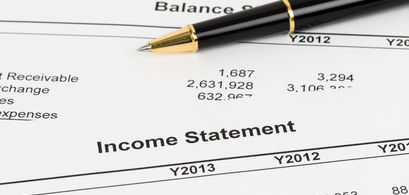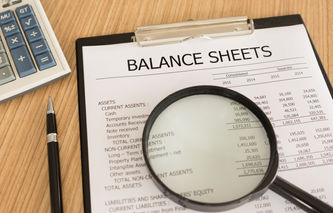This is the final article in our income statement series. In the sections below, we're going to explain how to build an income statement. Understanding the concepts behind net income, profitability, or corporate earnings helps investors and creditors to gain a better understanding of a company's financial wellbeing.
Income Statement: Strengths and Weaknesses
The income statement tells the investor what's left after all the company's expenses have been paid: net income. This is an important measure of a company's overall profitability, and that's why it's sometimes referred to as the "bottom line."
Market analysts spend a lot of time discussing net income because it's used to derive earnings per share, which is an important measure of profitability. Since investors buy shares of stock, it's critically important for them to understand how much profit is returned to each share they own.
The down side of the income statement has to do with accounting adjustments, which can distort net income in any given year. For example, one-time gains can overstate net income. It's also a historical account of the company's performance. It doesn't tell the analyst anything about the future earning prospects of a company, its brand loyalty, or whether or not profits were merely the result of a change in an accounting method.
Simple Net Income Formula
As was the case with the other financial statements, we're going to build an income statement keeping the following ideas in mind:
Two areas need to be covered thoroughly in this statement: revenues and expenses, which can then be used to derive net income.
The need to account for the money coming into the company from consumers or customers, and this is called revenue.
The need to account for the money spent to sell products or services, which are expenses of the company.
This statement does not account for all of the money flows into and out of the company in a given year such as the money used for financing an operation. That information can be found in the statement of cash flows.
The simple building blocks of the net income formula include
+ Revenues - Expenses = Net Income
In order to build an income statement, the analyst or investor needs to be concerned with the accuracy of two pieces of information: revenues and expenses.
Income Statement Construct
The information that's discussed from this point forward is a tutorial that explains how to build an income statement. This report is also known as a profit and loss statement (P&L), and a consolidated statement of operations. The paragraphs below cover each section of this financial statement, and provide examples to better explain each concept. At the end of this process, there will be a link to a file that demonstrates all of the points discussed. This allows the end-user to visualize how these concepts fit together.
Revenues
Revenue is an accounting term used to describe the money a company receives from activities that include sales of products and / or services to customers. Some companies use the term revenue and sales interchangeably, while others use the term "sales" to describe the volume or number of products sold. For example, an electric utility might record sales of 40 billion kWh, and revenues of $4.5 billion.
The revenues for any period of time are equal to the inflow of cash plus the increase in accounts receivable. Companies recognize or "book" revenue when the goods or services are delivered to customers. Revenues have a positive effect on net income.
Fortunately, most companies track revenues in a very straightforward manner. They are usually stated as one-line item, which is labeled "revenues" or "operating revenues."
Expenses
In order to produce revenues, companies usually need to spend money, which are referred to as expenses. A company's expenses include costs such as the purchase of raw materials, sales and administrative salaries, as well as the depreciation of equipment used to make a product.
When building an income statement, accountants typically group costs into six categories:
Cost of Sales / Cost of Goods Sold
Selling, General, and Administrative (SG&A)
Depreciation / Amortization
Other Operating Expenses
Interest Expense / Interest Income
Income Taxes
Cost of Sales / Cost of Goods Sold
The cost of goods sold is all of the expenses a company incurs to make the products or provide the services offered. This would include any raw materials, expenses associated with running the factory such as electricity, and labor used to manufacture a product or provide a service.
Selling, General, and Administrative Expense (SG&A)
When a company attempts to make a sale of a product or service, they incur a selling expense. The general and administrative expenses are those costs associated with running a company. Activities such as staffing a human resources department or producing monthly performance scorecards are examples of administrative expenses. Selling expenses would include advertising and marketing monies, along with compensation paid to inside and outside salespersons.
Depreciation / Amortization Expense
When a company buys an asset that is utilized over a relatively long period of time, it's allowed to capitalize the purchase instead of expensing the cost. This purchase creates an asset on the balance sheet that the company then would expense gradually over time. This accounting treatment is allowed because it spreads the cost of the asset over the serviceable life of the equipment. This is the concept behind depreciation expense.
Depreciation allows a company to purchase an asset today, and allocate the cost over a longer period of time. Depreciation expense is sometimes referred to as a non-cash expense, because the company does not pay out money each year. The money left the company's bank account on the day it paid for the asset.
By depreciating the asset over time, the company does not have to write off the expense in one year. Instead, it might depreciate the purchase over five years. By doing so, the company does not sharply reduce net income in the year the asset is purchased. It allows the expense to follow the revenues produced by the asset over time.
The concept of amortization is nearly identical to depreciation, except that amortization usually relates to intangible assets. An example of an intangible asset might be goodwill associated with a popular brand name.
Other Operating Expenses
This category of costs includes all of the other operating expenses incurred by a company that were not included in the cost of goods sold, SG&A, or depreciation and amortization. The important point here is to report only those expenses associated with the company's primary operation.
Stock analysts pay very close attention to the expenses reported in this category because companies sometimes label what amount to annual expenses as "one time" charges. Examples of other operating expenses include restructuring expenses or the write down of assets.
Interest Expense / Interest Income
When a company places cash in short-term investments such as certificates of deposit, savings and money market accounts, these dollars earn interest. The interest earned on these types of accounts provides the company with a source of income that is accounted for on the income statement as interest income or revenue.
Interest expense, on the other hand, is the money paid to bondholders, or lenders such as banks, to pay the interest owed. The money associated with the loan is considered an asset of the company until it is used to purchase another asset such as plant machinery, or it is used to pay for other operating expenses. The interest on the bond or loan is considered interest expense, and is reported that way on the income statement.
Income Taxes
The last expense reported on the income statement is income taxes. This can be taxes at the federal, state, or local levels. This expense appears immediately before the calculation of net income occurs.
Income taxes should not be confused with other "deductible" expenses such as property taxes, which is an overhead cost and should be included as an operating expense. Property taxes are sometimes categorized as Taxes Other than Income Taxes.
Income Statement Worksheet
Reviewing what has been learned up to this point; if building a very simple income statement, it would look like the following:
Sample Income Statement
Revenues | $100 |
Less: | |
Cost of Goods Sold | $35 |
Selling, General and Administrative Expense | $15 |
Depreciation | $10 |
Other Operating Expense | $5 |
Total Operating Expense: | $65 |
Operating Income | $35 |
Interest Expense | $5 |
Income Before Income Taxes | $30 |
Income Tax Expense | $9 |
Net Income | $21 |
In the example above, there are two common interim calculations performed before net income is shown:
Operating Income: a measure of the earning power from a company's ongoing operations. Operating income is sometimes referred to as operating profit or earnings before interest and taxes (EBIT).
Income Before Income Taxes (IBIT): also known as gross profit or ordinary profit.
Income Statement Example
As promised, we're going to finish this article, and series, by providing a link to an income statement spreadsheet. In this Excel worksheet appears example information that was used throughout this tutorial, including all of the necessary calculations.
In addition to the information above, the example worksheet also contains categories such as:
Write Down of Assets: this occurs when an asset might have its useful life diminished, or when the company decides the asset is not as valuable as once thought.
Taxes Other than Income Taxes: includes property taxes and some industry-specific regulatory taxes such as gross receipts and franchise tax.
The example also demonstrates how the income statement is used to calculate earnings per share, one of the most important financial measures of a company's ability to remain a viable operation.
This article finishes a three-part series on the income statement, which included the articles analyzing income statements as well as understanding net income.




